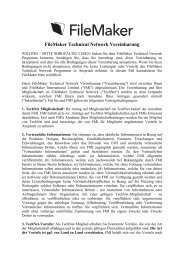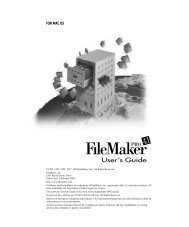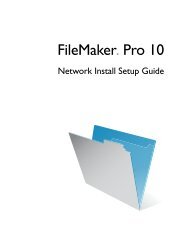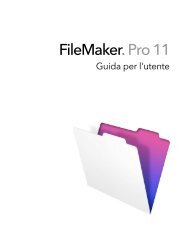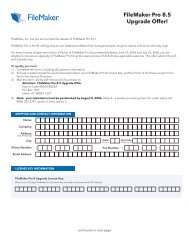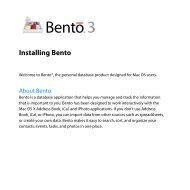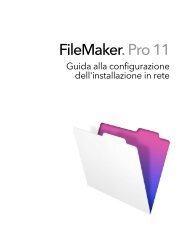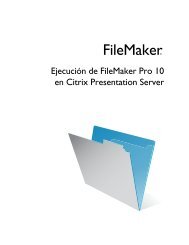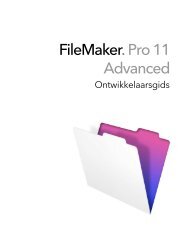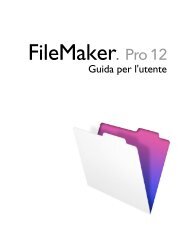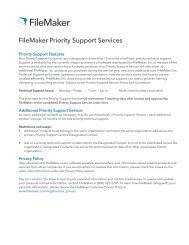Guida di FileMaker Server 12
Guida di FileMaker Server 12
Guida di FileMaker Server 12
You also want an ePaper? Increase the reach of your titles
YUMPU automatically turns print PDFs into web optimized ePapers that Google loves.
Utilizzo <strong>di</strong> ODBC e JDBC con <strong>FileMaker</strong> <strong>Server</strong><br />
Utilizzo <strong>di</strong> ODBC e JDBC con <strong>FileMaker</strong> <strong>Server</strong><br />
Nota Le seguenti informazioni sono destinate ad amministratori server.<br />
Importante La con<strong>di</strong>visione ODBC e JDBC è <strong>di</strong>sponibile solo se si possiede una licenza <strong>di</strong><br />
<strong>FileMaker</strong> <strong>Server</strong> Advanced.<br />
È possibile utilizzare <strong>FileMaker</strong> <strong>Server</strong> come:<br />
• origine dati, se si <strong>di</strong>spone <strong>di</strong> una licenza <strong>di</strong> <strong>FileMaker</strong> <strong>Server</strong> Advanced. È possibile<br />
con<strong>di</strong>videre i file <strong>di</strong> database <strong>FileMaker</strong> Pro ospitati con altre applicazioni sullo stesso<br />
computer oppure attraverso una rete usando ODBC (Open Database Connectivity) e JDBC<br />
(Java Database Connectivity). Ad esempio, è possibile creare grafici, analizzare numeri e<br />
generare resoconti utilizzando dati <strong>FileMaker</strong> Pro in altre applicazioni.<br />
• applicazione client ODBC. I database <strong>FileMaker</strong> Pro ospitati possono interagire con le<br />
origini dati sullo stesso computer o in rete. Ad esempio, i database <strong>FileMaker</strong> Pro ospitati<br />
possono lavorare interattivamente con un’origine dati Oracle come definito nel grafico delle<br />
relazioni e nei formati <strong>di</strong> <strong>FileMaker</strong> Pro.<br />
<strong>FileMaker</strong> <strong>Server</strong> Advanced come origine dati<br />
<strong>FileMaker</strong> <strong>Server</strong> Advanced comprende il software necessario per con<strong>di</strong>videre database come<br />
origini dati tramite ODBC e JDBC, compresi i driver client <strong>FileMaker</strong> utilizzati per accedere ai database<br />
da altre applicazioni compatibili con ODBC o JDBC. Per informazioni sull’abilitazione <strong>di</strong> un file <strong>di</strong><br />
database per la con<strong>di</strong>visione vedere Con<strong>di</strong>visione <strong>di</strong> database <strong>FileMaker</strong> tramite ODBC e JDBC.<br />
Per ulteriori dettagli su istruzioni SQL, espressioni, funzioni Catalogo e driver client, consultare la<br />
GUIDA ODBC E JDBC DI FILEMAKER sulla Pagina iniziale.<br />
<strong>FileMaker</strong> <strong>Server</strong> come applicazione client ODBC<br />
Se si usa <strong>FileMaker</strong> <strong>Server</strong> o <strong>FileMaker</strong> <strong>Server</strong> Advanced come applicazione client, è necessario<br />
installare e configurare i driver per le origini dati ODBC per accedere e impostare i nomi delle origini<br />
dati (DSN) per cui i database <strong>FileMaker</strong> Pro ospitati sono progettati. Ad esempio, per accedere ai<br />
dati da un database Oracle utilizzando ODBC è necessario installare e configurare un driver client<br />
Oracle ODBC e impostare esattamente lo stesso DSN per cui il database <strong>FileMaker</strong> Pro è stato<br />
progettato. <strong>FileMaker</strong> <strong>Server</strong> supporta vari driver <strong>di</strong> altri produttori. Per ulteriori informazioni vedere<br />
Accesso a origini dati ODBC esterne.<br />
Consultare la <strong>Guida</strong> <strong>di</strong> <strong>FileMaker</strong> Pro per ulteriori informazioni su:<br />
• uso interattivo <strong>di</strong> origini dati ODBC, in tempo reale, nel grafico delle relazioni e nei formati.<br />
• importazione <strong>di</strong> dati ODBC in operazioni batch con query SQL.<br />
GUIDA DI FILEMAKER SERVER <strong>12</strong> 98



